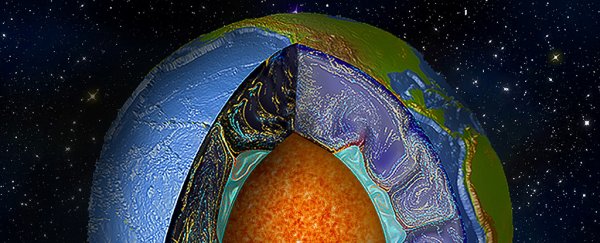You might think geologists have a pretty good idea about the inner workings of the Earth's mantle - that hot, rocky region between the crust and the core that makes up 84 percent of the total volume of our planet.
But a new study suggests that the mantle's movement could be affected by factors we haven't even yet considered yet, and that could completely change our thinking about earthquakes, volcanoes, and other plate-shifting events.
The new research, conducted by a team from the University of Columbia, focusses on two layers: the lithosphere, which holds the crust, the upper mantle, and the tectonic plates that slowly slide across Earth's surface; and the deeper asthenosphere, a hotter and more viscous part of the mantle believed to help drive the movement of the plates above.
Until now, it was thought that major pulls and pushes in tectonic plates - caused by rising and sinking sections of the lithosphere - were what triggered the majority of the movement underneath in the asthenosphere. Now it appears that smaller, more independent factors could have an influence, too.
The researchers attached an array of seismometers on the floor of the Pacific Ocean to get a closer look at mantle convection and plate tectonics based on the vibrations detected from earthquakes.
In particular, they looked at patterns created in crystals called olivine - patterns that are dictated by the flow of Earth's mantle, and which can be deciphered from the speed of seismic waves.
Surprisingly, the olivine patterns didn't match with the movements of tectonic plates, and were apparently not hugely affected by those major pulls and pushes in the lithosphere above. The main flow of movement seemed to be happening 250 kilometres (155 miles) down.
 Jose F. Vigil/USGS
Jose F. Vigil/USGS
The team thinks that pressure caused by different temperatures inside the mantle could be causing small-scale convection. Essentially, these small-scale processes could be more significant than the plate-driven deformation higher up in the mantle.
"Our data suggests that there are two other processes in the mantle that are stronger [than the influence of moving plates]," explains study co-author and geophysicist, James Gaherty.
"One, the asthenosphere is clearly flowing on its own, but it's deeper and smaller scale; and, two, seafloor spreading at the ridge produces a very strong lithospheric fabric that cannot be ignored."
It's still not clear exactly how the asthenosphere works and in which directions its materials are flowing, but there's now a solid foundation for future study. The team's work has been published in Nature.
And that's not the only recent discovery that sheds new light on what's going on below Earth's surface. Last month, researchers from Arizona State University found that two large 'blobs' sitting inside the planet - each the size of a continent and about 2,900 kilometres (1,800 miles) down - are made of a different material than the rest of the mantle.
"While the origin and composition of the blobs are yet unknown, we suspect they hold important clues as to how Earth was formed and how it works today," explained one of the team, Edward Garnero. It's possible that these previously undetected blobs also have a role to play in the movements of the mantle being analysed in the first study we mentioned.
Again, the speeds of seismic waves were used to determine that these blobs are made up of different stuff - whatever it turns out to be - than the materials around them. These new findings have been published in Nature Geoscience.
